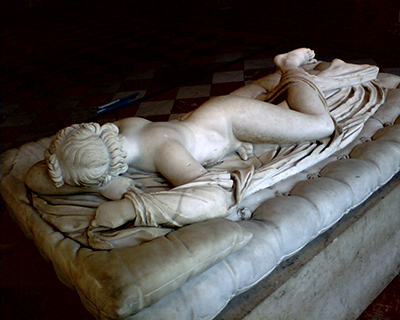This ancient marble sculpture depicts Hermaphroditus life size. It is not clear who sculptured this statue, but it is well known that Gian Lorenzo Bernini carved the mattress in 1620.
The structure is partially derived from the ancient portrayals of Venus, and partly from the contemporaneous feminised Hellenistic Dionysus/Bacchus portrayals. The Sleeping Hermaphroditus is noted as an early Imperial Roman copy of the original bronze which was indicated in Pliny's Natural History. The bronze sculpture was designed by the subsequent of the two Hellenistic sculptors called Polycles. From the look of other sculpture versions that have survived, this sculpture represents a subject that was persistent in ancient Rome and in Hellenistic times. It was discovered at the Santa Maria Della Vittoria in Rome. The discovery came about either during the planting of espaliers or during the digging of the foundations of the church.
This sculpture was given to the maven, Cardinal Scipione Borghese, who then granted the order to the services of his then architect, Giovanni Battista Soria. The connoisseur paid for the church`s façade sixteen years later. In 1620, Gian Lorenzo Bernini received sixty scudi for carving the buttoned mattress, on which the Hermaphroditus rests. Principe Camillo Borghese sold the Sleeping Hermaphroditus in 1807 among other artworks from the Borghese Collection. The piece was relocated to The Louvre, and it inspired Algernon Charles Swinburne's poem titled Hermaphroditus in 1863.
During 1781, a second-century copy of the original Sleeping Hermaphroditus was discovered. It has now taken the place of the original piece at the Galleria Borghese. Subsequently, a third Roman marble form was found in 1880, during the building works to turn Rome into the capital of united Italy. This piece is now displayed at the Museo Palazzo Massimo Alle Terme. Other ancient copies are found at Vatican Museums in Vatican City, Uffizi in Florence, and the Hermitage Museum.
The Sleeping Hermaphroditus has been inspiring modern sculpturists. Since the Renaissance, there have been plenty of copies in various scales and media. Full-size copies were created in bronze for Philip IV of Spain, ordered by Velázquez and are now in the Prado Museum. Other copies were made in marble by Martin Carlier for Versailles.
The composition has also influenced Velázquez's painting of Rokeby Venus, which is now in London. A smaller-scale bronze copy, which was designed and signed by Giovanni Francesco is now located at the Metropolitan Museum. There is also another small-scale copy created in ivory by sculptor François Duquesnoy.
This piece was bought in Rome by John Evelyn during the 1640s. Barry X Ball, an American artist created a life-size copy of the sculpture after the Louvre's version. It is made out of Belgian black marble and set on Carrara marble base. Barry's statue was completed in 2010 and was offered at the Christies NY for sale on 10 May 2016. The estimated price is $500,000 - $800,000. The Borghese Hermaphroditus was sold to the French years after its discovery and was later relocated to The Louvre, where it`s on display.




